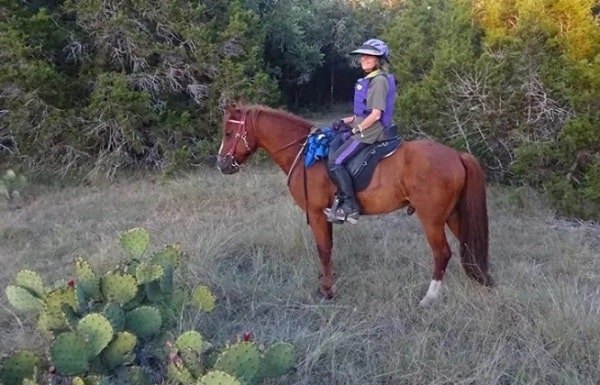My Treeless Journey – Bobbie Jo Lieberman

By Bobbie Jo Lieberman
Soon after I finished my first 100-mile endurance ride in a borrowed Stubben Columbo made of buffalo hide, the first of a new generation of treeless saddles was creating a buzz in the horse world. In the early 1980s, treeless was a new and captivating idea. After our fifth-place finish on the Old Dominion, friend and fellow competitor Bob Walsh let me trot his Arab gelding Houdini around camp in his Bob Marshall SportSaddle.
I still remember that ride. The saddle felt very different at first, as if I were riding in a bareback pad, but it was sure comfortable. I decided I wanted one. Later that year at the Fort Valley ride, another rider didn’t get along so well with her SportSaddle and threw it down in the back of her SUV. “Here—it’s yours for $500.” Well, that was an offer I couldn’t refuse. Although the saddle was wet and bore her initials, it was a good buy, and thus began my treeless journey.
I completed three more OD 100s in that SportSaddle. I loved it; it was lightweight and easy to ride in. On a training ride one day, I noticed the pommel was off center. There was play in the cantle and pommel and, as it turned out, the tree was broken. Undaunted, I shipped the saddle back to the manufacturer in Kentucky. They not only fixed it, but changed the seat size for me. I was a happy camper and treeless fan.
I ended up riding that SportSaddle on several horses until I returned to treed saddles some years later. Meanwhile, treeless designs continued innovating and entering the market. By the turn of the millennium, we had Freeform saddles, Ansur, Sensation, Barefoot, Black Forest, Trekker and more.
There seemed no limit to the treeless movement. Yet the debate—treed vs. treeless—raged on. Riders, it seemed, either loved them or hated them. Yes, treeless had their issues—they could be “tippy” while the rider mounted from the ground. A heavyweight or unbalanced rider could cause back soreness in their mount over long miles. The positioning of the stirrup could create pressure points on the horse’s back.
But in many cases, going treeless solved longstanding issues for asymmetrical or otherwise difficult to fit equines. The endurance community and its relentless search for “what works” seemed to embrace treeless in a big way, along with other nontraditional saddles—flexible and adjustable paneled saddles such as ReactorPanel, Specialized and Free N Easy. At one point or another, I tried most of them. I liked the adjustability and larger bearing surface of the nontraditional designs.
Although I had returned to treed saddles in the mid-1990s, I was constantly daydreaming about treeless. I wanted to try one again. My friend Audrey Hager, who was riding my TWH Jazz on 50-milers, had purchased a Freeform and loved the comfort and security. But over the miles, Jazz developed white hairs behind the withers. Paulita of Freeform came to the rescue. She determined that the Skito pad we were using on Jazz wasn’t quite getting the job done. She sent us a dryback Skito with high-density foam and a second layer of laminated foam. It had amazing stiffness yet was able to mold to the horse’s back. Since switching to this pad and a larger seat, Jazz has completed a string of 50s including two sets of back to back 50s (100 miles in two days). She is the #1 horse in the Middleweight Division of the AERC Central Division and has never looked better. Some folks are encouraging us to aim her for Tevis.
While living vicariously through Jazz’ exploits, I’ve been searching for my own brand of treeless paradise. I tried a prototype of the Freeform Scout and liked it very much. I can’t wait to see what Paulita comes up with next! If going treeless is on your radar, do keep in mind that a supportive pad with a channel to ensure spinal clearance is a must. As luck would have it, Paulita recently designed and introduced a new Freeform pad that should work perfectly with most treeless saddles.
Treeless saddles have become a permanent feature of the equestrian landscape. They solve a host of fitting challenges and work on horses of varying and changing conformation. Many horsemen appreciate the flexibility, light weight and comfort they offer both horse and rider. While treeless saddles may not be for every horse and rider, they have found a place in the horse world. I’m happy I came home to treeless!
Bobbie Jo Lieberman is an endurance rider, equine photojournalist and blogger based in Texas and New Mexico. She is former Editor-in-Chief of Trail Blazer magazine and Senior Editor of EQUUS, to which she still regularly contributes. Bobbie and her husband Kenny Weber are building a horse ranch from scratch on their property near Pie Town, New Mexico.
PHOTO above: Bobbie Jo Lieberman in her Freeform Scout.


Leave a comment
Also in News
Freeform Treeless Saddle Giveaway - Winner
By Paulita Neff March 01, 2024 118 Comments
Continue reading
Saddle Pad Giveaway - Winners
By Paulita Neff February 01, 2023 44 Comments
Winners Announcement! Woohoo – thanks to everyone who entered - our Saddle Pad Giveaway WINNER is Jennifer Morris and her horse Pete!
Continue reading
This Saddle Is Truly Revolutionary
By Paulita Neff September 06, 2022
Continue reading